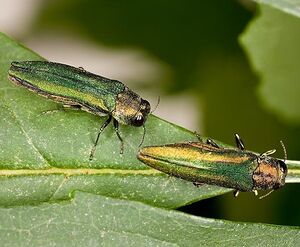Jewel Beetle
The Jewel Beetles is a group also known as the Buprestidae. In this family of beetles, there are over 15,500 different species that can be found all over the world. Another common name for this group is the metallic wood-boring beetle. This is due to their shiny iridescent-like body [1]. This group is the most commonly collected beetle type for insect collectors, strictly due to its bright and showy colors. One of the most famous examples of a beetle from this family is the emerald ash borer, an invasive beetle that is terrorizing Ash trees across North America [2].

Taxonomy
Kingdom: Animalia
Phylum: Arthopoda
Subphylum: Uniramia
Class: Insecta
Order: Coleoptera
Sub Order: Polyphaga
Family: Buprestidae

Description
Jewel Beetles are easily identified due to their elongated and oval bodies tapering to a point near the end. Their lengths can measure anywhere from 3mm to 80mm; however, many species are below the 20mm mark [2]. They are hard-bodied insects, rather than flat. Their colors range from many different shades. Some examples being dull browns and blacks, all the way to neon and chrome greens and purples [2]. Their color is created in a different way than many others. They have a textured cuticle that reflects the light differently, causing the bright patterns and different hues of colors [4]. The larvae tunnel their way inside the interior of the host's tree trunk and emerge from the bark when they are ready and matured [3]. Usually focusing on dead, decaying branches on healthy trees, this is where the first part of the life cycle beings for the Jewel Beetle family [4]. There are four stages of life within these beetles. The egg, larva, pupa, and adult. Once adults, they die in a relatively short time frame. Most species only live between a few days and 3 weeks [5]. There have been over 100 different species found that have been fossilized and not seen anywhere else yet [6].
Diet & Food Behavior
Mainly active during the day, Jewel Beetles spend their nights hiding under leaves and other plant material they can find along the ground. Their diet consists of leaves, nectar, stems, roots, and soft/dead trees and grasses. Some beetles tend to target crops on farm fields and can cause large amounts of economic damage [5].
Habitat and Distribution
Jewel beetles tend to live in forests and woodlands. Many species are found in Australia (1,200 current different species) and can be seen feeding on and flying around flowers and trees [1]. Some species like the above Emerald Ash Borer are extremely invasive and take over large areas. Jewel Beetles can be found all over the world but tend to cluster in warmer climates. All over the world, these beetles have been used for generations in many different ways. Places that have large handmade jewelry businesses can also see a spike in these beetles [1]. Hence the name Jewel Beetle. Some are able to live very close, if not in, freshwater environments, while others are able to survive inside bright, high-up areas with no problem [4].
Control Systems

Controlling beetles can be very challenging and there are not many methods that are guaranteed to work. The first way is hand plucking the beetles off of the plant/tree [7]. This is a method that will remove the beetle without any other effects. When the beetles are in their larva state, spraying with certain pesticides is another common method for removal [7]. However, some beetles are so invasive and hard to get rid of, we simply just let them run their course. Mitigation of these resilient invasive bugs can be very difficult. Millions of dollars have been spent on eradication throughout the country with little success. The Emerald Ash Borer alone has caused 0.8-3.4 million dollars in landscape damages. The only way to remove all of the Borers is to let them run out of food (the ash trees) and die out naturally.
References
[1] Jewel Beetle. (n.d.). . https://australian.museum/learn/animals/insects/jewel-beetle/australian.museum/learn/animals/insects/jewel-beetle/.
[2] What Are Jewel Beetles? (n.d.). . https://www.thoughtco.com/jewel-beetles-family-buprestidae-1968126.
[3] Jewel Beetle 2. (2022). . https://www.insectidentification.org/insect-description.php?identification=Jewel-Beetle.
[4] Buprestidae. 2021, August 26. .
[5] Jewel Beetles: Natural History and Interesting Facts. 2020, March 25. .
[6] Fabio. (n.d.). Jewel Beetles - Learn About Nature. https://www.learnaboutnature.com/insects/beetles/jewel-beetle/.
[7] How to Protect Your Garden from Japanese Beetles. (n.d.). . https://www.thespruce.com/controlling-adult-japanese-beetles-1402495.
[8] The potential economic impacts of Emerald Ash Borer. (2007). .